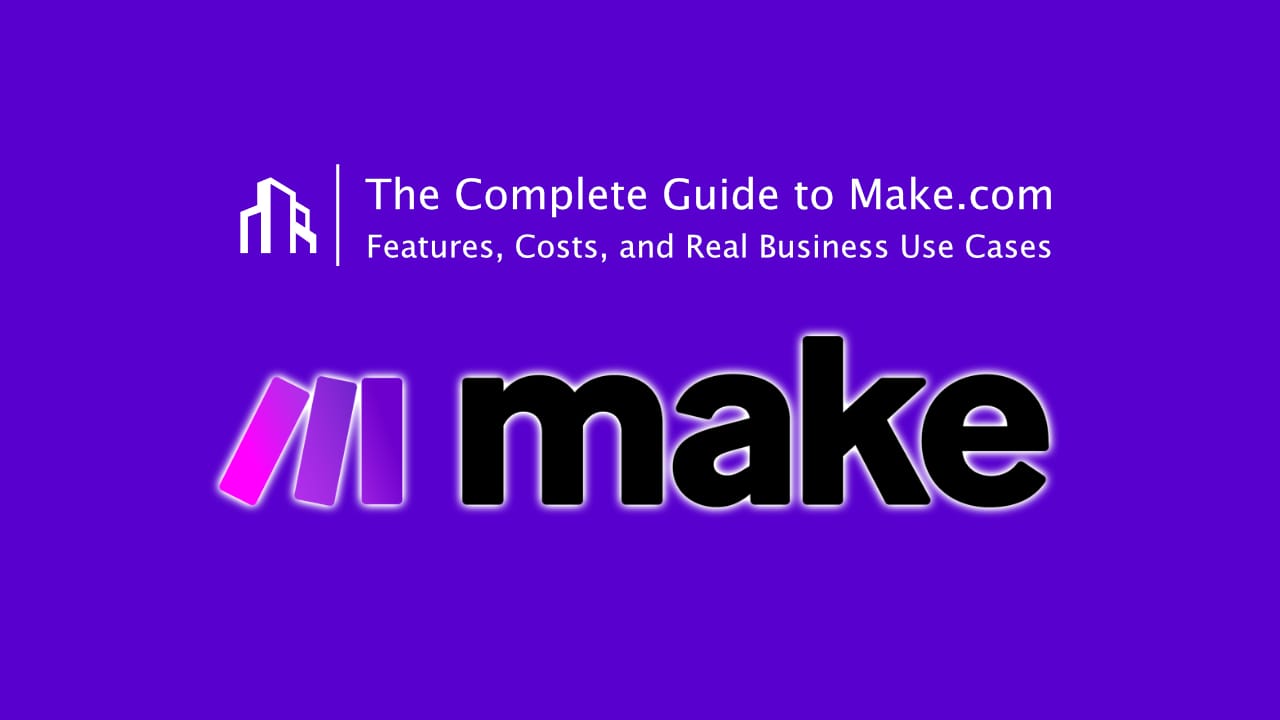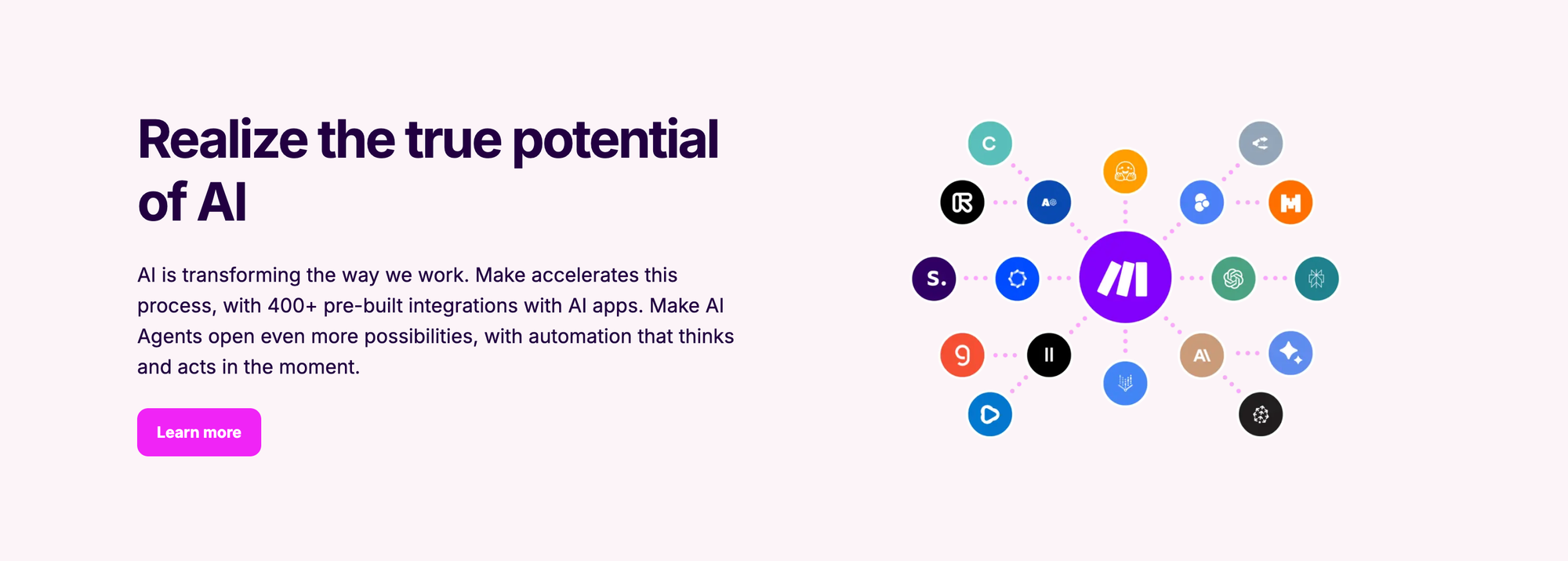The Complete Guide to Make.com: Features, Costs, and Real Business Use Cases

Make.com has become one of the most versatile automation platforms for startups, SMEs, and enterprises alike. Whether you want to connect your CRM with marketing tools, automate onboarding, or scale campaign performance with AI, Make provides the flexibility to design complex workflows without writing endless custom code.

Make.com Automation
Build and scale powerful automations fast. Scalevise designs reliable Make.com scenarios, handles complex logic and error handling, and keeps costs predictable as you grow.
- ✓ Expert scenario design & orchestration
- ✓ Robust error handling, retries & logging
- ✓ Clean handover with documentation & monitoring
At Scalevise, we’ve implemented Make in real businesses from Shopify automation to fintech KYC verification and we’ve documented every step. This page acts as a comprehensive hub for everything you need to know about Make.com, including features, pricing, pros and cons, and practical case studies.

Why Businesses Choose Make.com
- Visual Workflow Builder — drag-and-drop editor with hundreds of ready-made modules.
- Scalability — supports simple tasks as well as enterprise-grade workflows.
- AI & API Friendly — integrate GPT models, third-party APIs, and custom endpoints.
- Cost-Efficiency — cheaper than most competitors when optimized correctly.
- Flexibility — supports both no-code and advanced custom scripting.
👉 If you’re wondering whether Make is truly the backbone of modern business automation, we’ve explored that in detail here:
Why Make.com Is the Backbone of Modern Business Automation (and When It’s Not Enough)
Make.com Pricing: Credits vs Operations
In 2025, Make shifted from operations to a credit system. This has caused a lot of confusion among users.
- Standard modules = still 1 credit
- AI modules = consume multiple credits depending on tokens, file size, or complexity
- Using your own OpenAI/Claude key = predictable 1 credit per run
We’ve broken this down with tables, examples, and cost-saving strategies here:
Make.com Credit Costs Explained: Are You Paying More?
Comparing Make vs Competitors
Make is not the only automation tool in the market. Businesses often ask whether they should choose Make, Zapier, or n8n.
- Zapier is great for quick plug-and-play use cases, but expensive at scale.
- n8n is open source and self-hosted, offering unlimited executions.
- Make balances power with usability and pricing, especially for SMEs.
Read our full comparison guides:
- Make vs n8n vs Zapier: Which No-Code Automation Tool Should You Use?
- Make vs Zapier vs n8n: Which Automation Tool Should You Bet Your Business On in 2025?
And if you’re considering migrating from Make to n8n, we’ve got you covered:
Migration Guide: How to Move from Make.com to n8n Without Breaking Everything
Make + AI

Real Business Use Cases with Make.com
We don’t just talk about theory. Scalevise has built and documented real projects with measurable results.
1. Marketing Campaign Automation
A marketing agency scaled its ROI by 300% using Make + Airtable + AI.
👉 How a Marketing Agency Scaled Campaign ROI by 300% with Make.com, Airtable & AI
2. Content Marketing at Scale
We built a fully automated content marketing engine powered by Make.
👉 How We Built an Automated Content Marketing System with Make
3. Shopify Automation
A Shopify store reduced manual work by 80% with custom Make workflows.
👉 How We Automated a Shopify Store with AI + Make.com
4. Fintech Compliance
Automating KYC verification for a fintech company with APIs and Make.
👉 Automating KYC Verification with AI APIs and Make
5. Project Administration
Integrating Jira and Airtable with Make to handle logs, costs, and dashboards.
👉 Jira + Make + Airtable Automation
6. Solution Architecture: Softr + Airtable + Make
Check out our in-depth breakdown of how Softr, Airtable, and Make work together to power client portals, internal tools, and automation workflows.
👉 Softr + Airtable + Make – A Scalable No-Code Architecture
7. Sales Pipeline Automation
We implemented a fully automated sales workflow using Pipedrive and Make for a B2B client. The system tracks incoming leads, updates pipeline stages, notifies sales reps in real-time, and automatically creates tasks, all without manual input.
👉 How We Automated a B2B Sales Pipeline Using Make and Pipedrive
CRM Workflow Automation
Most CRMs promise efficiency, but without automation they quickly turn into data silos. We designed a scalable CRM workflow using Pipedrive, Airtable, and Make to connect sales, marketing, and reporting in one flow. Deals are updated automatically, leads are routed to the right rep, and managers receive real-time dashboards without manual exports.
👉 CRM Workflow Automation – How to Build Smarter Sales Processes

Onboarding Automation: From 2 Weeks to 2 Hours
Employee and client onboarding is a pain point in many organizations. With Make.com, workflows that previously took weeks can be reduced to hours.
We’ve written two in-depth onboarding guides:
- Automating Onboarding with Make: From 2 Weeks to 2 Hours
- Automated Onboarding with Make.com: Save Time, Cut Costs, Scale Faster
Advanced Topics: Custom AI Systems & Middleware
Sometimes Make isn’t enough by itself. Businesses need hybrid setups where Make works alongside custom middleware or enterprise-grade AI stacks.
Read more:
Custom AI Systems vs SaaS Chaos: Where Middleware Wins
And for those experimenting with AWS Bedrock’s AgentCore:
AgentCore Memory & VPC Costs: The Missing Line Items
Final Thoughts
Make.com is not just another no-code tool. It’s a scalable automation backbone for businesses that want flexibility without giving up speed.
At Scalevise, we help companies:
- Audit and optimize existing Make workflows
- Migrate from Make to n8n when cost or compliance demands it
- Integrate AI agents directly into Make scenarios
- Build monitoring, dashboards, and real-time alerts

Make.com Automation
Build and scale powerful automations fast. Scalevise designs reliable Make.com scenarios, handles complex logic and error handling, and keeps costs predictable as you grow.
- ✓ Expert scenario design & orchestration
- ✓ Robust error handling, retries & logging
- ✓ Clean handover with documentation & monitoring
👉 Contact Scalevise today if you want to optimize your automation stack.
Frequently Asked Questions
Is Make.com free?
It offers a free tier with limited credits. For serious use cases, you’ll need a paid plan.
Can I integrate AI into Make?
Yes. Make supports GPT-powered modules and external APIs like OpenAI and Claude.
When should I choose n8n instead of Make?
If you need unlimited executions, self-hosting, or advanced error handling, n8n may be the better fit.
Does Scalevise provide Make implementation?
Absolutely. We specialize in complex workflow automation with Make, Airtable, and AI.
